
NGC 1705 is a peculiar lenticular galaxy and a blue compact dwarf galaxy (BCD) in the southern constellation of Pictor, positioned less than a degree to the east of Iota Pictoris, and is undergoing a starburst. With an apparent visual magnitude of 12.6 it requires a telescope to observe. It is estimated to be approximately 17 million light-years from the Earth, and is a member of the Dorado Group.
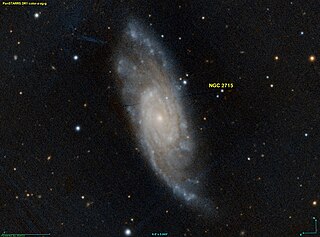
NGC 2715 is an intermediate spiral galaxy in the constellation Camelopardalis. It was discovered in 1871 by Alphonse Borrelly. It is an intermediate spiral galaxy that is 4.9 arcminutes wide.

NGC 2903 is an isolated barred spiral galaxy in the equatorial constellation of Leo, positioned about 1.5° due south of Lambda Leonis. It was discovered by German-born astronomer William Herschel, who cataloged it on November 16, 1784. He mistook it as a double nebula, as did subsequent observers, and it wasn't until the nineteenth century that the Third Earl of Rosse resolved into a spiral form. J. L. E. Dreyer assigned it the identifiers 2903 and 2905 in his New General Catalogue; NGC 2905 now designates a luminous knot in the northeastern spiral arm.
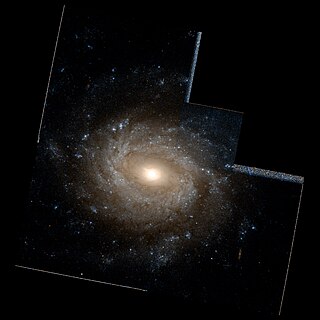
NGC 3486 is an intermediate barred spiral galaxy located about 27.4 million light years away in the constellation of Leo Minor. It has a morphological classification of SAB(r)c, which indicates it is a weakly barred spiral with an inner ring and loosely wound arms. This is a borderline, low-luminosity Seyfert galaxy with an active nucleus. However, no radio or X-ray emission has been detected from the core, and it may only have a small supermassive black hole with less than a million times the mass of the Sun.

NGC 4605 is a dwarf barred spiral galaxy in the constellation Ursa Major, located at a distance of 18.1 ± 0.3 megalight-years from the Milky Way. Physically it is similar in size and in B-band absolute magnitude to the Large Magellanic Cloud. It is a member of the M81 Galaxy Group, along with Messier 81 and Messier 101.

NGC 92 is a highly warped interacting unbarred spiral galaxy in Robert's Quartet; it is interacting with three neighbouring galaxies NGC 87, NGC 88 and NGC 89.

NGC 5755 is a barred spiral galaxy in the constellation Boötes, member of Arp 297 interacting galaxies group of four: NGC 5752, NGC 5753, NGC 5754, and NGC 5755.

NGC 5752 is a spiral galaxy in the constellation Boötes. It is a member of the Arp 297 interacting galaxies group which comprises four galaxies: NGC 5752, NGC 5753, NGC 5754, NGC 5755.
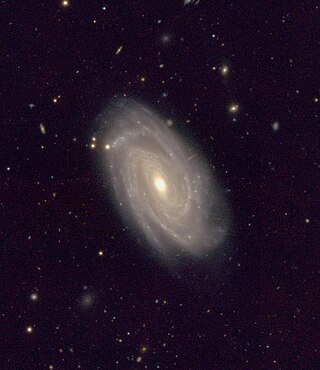
NGC 10 is a spiral galaxy located in the southern constellation of Sculptor. It was discovered by John Herschel on 25 September 1834. The galaxy is located at a distance of 346 Mly from the Sun. Its morphological classification in the De Vaucouleurs system is SAB(rs)bc, where the 'SAB' denotes a weak-barred spiral, '(rs)' indicates a slight ring-like structure, and 'bc' means the spiral arms are moderately to loosely wound. Paturel et al. (2003) assigned this galaxy a classification of SBbc, indicating a barred spiral galaxy.

NGC 24 is a spiral galaxy in the southern constellation of Sculptor, about 23.8 megalight-years distant from the Milky Way. It was discovered by British astronomer William Herschel in 1785, and measures some 40,000 light-years across. The general shape of this galaxy is specified by its morphological classification of SA(s)c, which indicates it is an unbarred spiral with no ring-like structure and moderate to loosely-wound spiral arms. This galaxy is positioned in the vicinity of the Sculptor Group, but is actually a background object that is more than three times as distant. It may form a pair with another background galaxy, NGC 45.
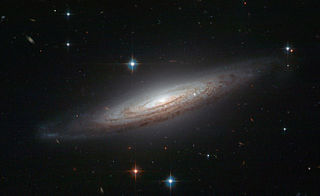
NGC 634 is a spiral galaxy, lying at a distance of 217.1 megalight-years away from the Milky Way in the northern constellation of Triangulum. This object was discovered in the nineteenth century by French astronomer Édouard Stephan. It is inclined by an angle of 82.4° to the line of sight from the Earth, and thus is being viewed nearly edge on.
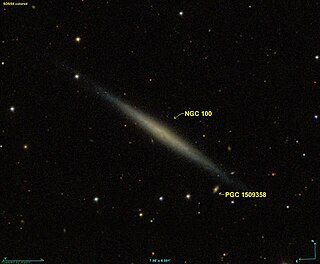
NGC 100 is a galaxy located approximately 60 million light-years from the Solar System in the constellation Pisces. It has an apparent magnitude of 13.2. It was first discovered on 10 November 1885 by American astronomer Lewis Swift.

NGC 2613 is a spiral galaxy in the southern constellation of Pyxis, next to the western constellation border with Puppis. It was discovered by the German-born astronomer William Herschel on November 20, 1784. With an apparent visual magnitude of 10.5, the galaxy is faintly visible using a telescope with a 100 mm (4 in) aperture. It appears spindle-shaped as it is almost edge-on to observers on Earth.

NGC 1084 is an unbarred spiral galaxy in the constellation Eridanus. It is located at a distance of about 63 million light-years away from the Milky Way. The galaxy was discovered by William Herschel on 10 January 1785. It has multiple spiral arms, which are not well defined. It belongs in the same galaxy group with NGC 988, NGC 991, NGC 1022, NGC 1035, NGC 1042, NGC 1047, NGC 1052 and NGC 1110. This group is in turn associated with the Messier 77 group.
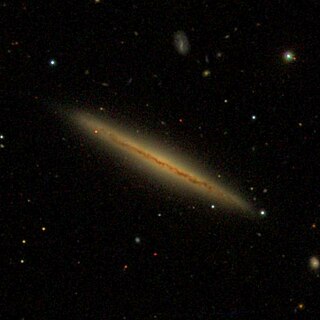
NGC 5470 is an edge-on spiral galaxy located between 43 and 68 million light-years away in the constellation Virgo. It was discovered by astronomer John Herschel in 1830. It is a member of the Virgo III Groups, a series of galaxies and galaxy clusters strung out to the east of the Virgo Supercluster of galaxies.
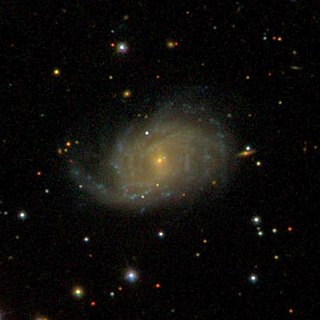
NGC 7046 is a barred spiral galaxy located 193 million light-years away in the constellation of Equuleus. With a high radial velocity of 4,130 km/s, the galaxy is drifting away from the Milky Way. NGC 7046 has an apparent size of 0.990 arcmin, and at its current distance, it has an estimate diameter of 192,639 light years. NGC 7046 has a morphological type of "SBc", which indicates that it is a barred spiral galaxy with a definite bulge.

NGC 479 is a spiral galaxy in the constellation Pisces. It was discovered by German astronomer Albert Marth on October 27, 1864. It is about 240 million light-years away from Earth.

NGC 972 is a dusty spiral galaxy in the northern constellation of Aries, located at an approximate distance of 49.8 Mly from the Milky Way. It was discovered in 1784 by William Herschel. The galactic features suggest it may have undergone a merger with a gas-rich companion, giving it asymmetrical arms, plus starburst activity in the nucleus and an off-planar nuclear ring. The inner 3.6 kpc of the galaxy is undergoing star formation at the rate of 2.1–2.7 M☉·yr−1, but it lacks a nuclear bulge.

NGC 701 is a spiral galaxy with a high star formation rate in the constellation Cetus. It is estimated to be 86 million light years from the Milky Way and has a diameter of approximately 65,000 light years. The object was discovered on January 10, 1785 by the German-British astronomer William Herschel.

NGC 821 is an elliptical galaxy in the constellation Aries. It is estimated to be about 80 million light-years from the Milky Way and has a diameter of approximately 55,000 light years. NGC 821 was discovered on September 4, 1786, by astronomer Wilhelm Herschel.




















